New Method for Petrochemical Refineries to Turn a Smelly Byproduct into Cash
Rice University engineers and researchers have developed a method for petrochemical refineries to turn a smelly byproduct into cash.Rice engineers have developed a method that uses gold nanoparticles to convert hydrogen sulfide into high-demand hydrogen gas and sulfur in a single step. The one-step process gets all its energy from light.

Figure 1: Light-powered catalyst makes hydrogen energy from pungent gas.
Figure 1 shows thatthe team dotted the surface of grains of silicon dioxide powder with tiny islands of gold. Each island was a gold nanoparticle about 10 billionths of a meter across that would interact strongly with a specific wavelength of visible light. These plasmonic reactions create “hot carriers,” short-lived, high-energy electrons that can drive catalysis. [1]
Hydrogen sulfide gas has the unmistakable aroma of rotten eggs. It often emanates from sewers, stockyards and landfills, but it is particularly problematic for refineries, petrochemical plants and other industries, which make thousands of tons of the noxious gas each year as a byproduct of processes that remove sulfur from petroleum, natural gas, coal and other products.
In the study, Halas and co-authors used a laboratory setup and showed a bank of LED lights could produce hot carrier photocatalysis and efficiently convert H2S directly into H2 gas and sulfur. That’s a stark contrast to the established catalytic technology refineries use to break down hydrogen sulfide.
Known as the Claus process, it produces sulfur but no hydrogen, which it instead converts into water. The Claus process also requires multiple steps, including some that require combustion chambers heated to about 1,500 degrees Fahrenheit.
The plasmonic hydrogen sulfide remediation technology has been licensed by Syzygy Plasmonic, a Houston-based start-up company with more than 60 employees, whose co-founders include Halas and Nordlander. [2]
Halas said the remediation process could wind up having low enough implementation costs and high enough efficiency to become economical for cleaning up nonindustrial hydrogen sulfide from sources like sewer gas and animal wastes.
"Given that it requires only visible light and no external heating, the process should be relatively straightforward to scale up using renewable solar energy or highly efficient solid-state LED lighting," she said. [3]
References:
- https://www.inceptivemind.com/light-powered-catalyst-makes-hydrogen-energy-pungent-gas/28061/
- https://hydrogen-central.com/light-powered-catalyst-makes-hydrogen-energy-pungent-gas-step-process/
- https://www.sciencedaily.com/releases/2022/10/221031124628.htm
Cite this article:
Sri Vasagi K (2022) New Method for Petrochemical Refineries to Turn a Smelly Byproduct into Cash, Anatechmaz, pp. 424

